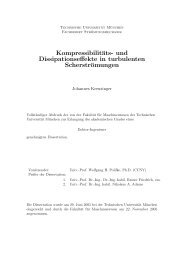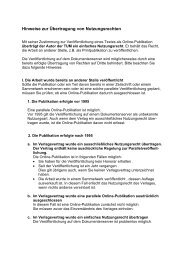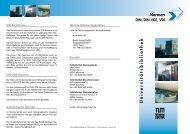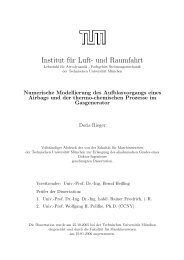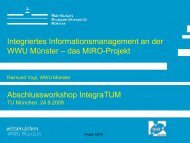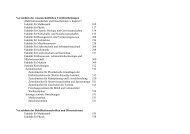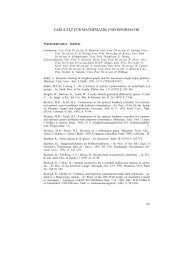LES of shock wave / turbulent boundary layer interaction
LES of shock wave / turbulent boundary layer interaction
LES of shock wave / turbulent boundary layer interaction
Create successful ePaper yourself
Turn your PDF publications into a flip-book with our unique Google optimized e-Paper software.
Chapter 1<br />
Introduction<br />
Design <strong>of</strong> new high-speed vehicles requires a detailed knowledge <strong>of</strong><br />
the flow behavior at supersonic and hypersonic speeds. Traditionally, the<br />
experiment was the major source <strong>of</strong> such knowledge. Growing computer<br />
power and development <strong>of</strong> reliable numerical techniques made it possible<br />
to obtain more detailed data from numerical modeling. Currently<br />
the flow field around an entire aircraft configuration can be modeled<br />
numerically based on inviscid and viscous models (Agarwal, 1999). Utilizing<br />
the Euler equations allows to capture the global flow structure,<br />
but because viscosity is neglected it cannot predict separation related to<br />
viscous-inviscid <strong>interaction</strong> (e.g. Volkov et al. (2002); Volkov & Loginov<br />
(2000)). Obtaining reliable results in case <strong>of</strong> <strong>turbulent</strong> flow, which is<br />
virtually every flow encountered in practical applications, is even more<br />
complicated. In spite <strong>of</strong> more than a century <strong>of</strong> research on <strong>turbulent</strong><br />
motion, a closed theory still does not exist. Shock <strong>wave</strong>s and their<br />
<strong>interaction</strong> with <strong>turbulent</strong> <strong>boundary</strong> <strong>layer</strong>s are accompany flight at supersonic<br />
speeds. The <strong>shock</strong> <strong>wave</strong> / <strong>turbulent</strong> <strong>boundary</strong> <strong>layer</strong> <strong>interaction</strong><br />
(SWTBLI) can have very complicated appearance. It usually occurs in<br />
inlets, near deflected control surfaces, near surfaces junctions, and has<br />
a big influence on structural loads, sometimes causing aircraft damage.<br />
This necessitates a reliable prediction tool with the ability to capture all<br />
relevant physical phenomena.<br />
Two basic ways <strong>of</strong> computing turbulence have traditionally been direct<br />
numerical simulation (DNS) and Reynolds-averaged (RANS) modeling.<br />
In the former, the full, time-dependent, Navier-Stokes equations are<br />
solved numerically, essentially without approximations. The results are<br />
expected to be equivalent to experimental ones. In the latter, only the<br />
statistical mean flow is computed, and the effect <strong>of</strong> the <strong>turbulent</strong> fluctuations<br />
is modeled according to a variety <strong>of</strong> physical approximations. It<br />
was realized early that direct numerical simulations were too expensive<br />
for most cases <strong>of</strong> industrial interest, while Reynolds-averaged modeling<br />
was too dependent on the characteristics <strong>of</strong> particular flows for being<br />
generally applicable. Large-eddy simulations (<strong>LES</strong>) were developed as<br />
an intermediate approximation between these two approaches, the general<br />
idea being that the large, non-universal, scales <strong>of</strong> the flow were to



